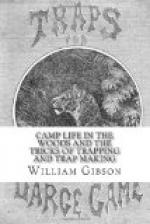Hunting.”—Luminosity of the Eyes of
the Deer at Night.—Hunting the deer with
dogs.—“Deer Licks.”—How
Salt is used in Hunting the Deer.—Hunting
from a Scaffolding.—Peculiar Sight of the
Deer.—“Salt Licks” used in Night
Hunting.—Head Lantern.—How made.—How
used.—The fiery Eyes of the Deer.—“Fox
Fire” or Phosphorescent wood.—How
used by the Hunter.—Seasons for Deer Hunting.—How
to skin the Deer.—
The moose.—Description
of the animal.—Immense size of its Horns.—Moose
yards.—Hunted on Snow shoes.—The
dangers of Moose Hunting.—Exquisite sense
of Smell.—How the Moose is Trapped.—Directions
for removing the Skin of the Animal.—
Rocky
mountain sheep.—Description of
the Animal.—Its enormous Horns.—Habits
of the creature.—Its flesh as Food.—How
the Animal is Trapped.—
The buffalo.—Its
Habits.—Its Food.—Buffalo-grass.—How
the Animal is Hunted and Trapped.—Buffalo
[Page ix] flesh as Food.—Buffalo skins.—
The
prong horn antelope.—Description
of the Animal.—Peculiarity of Horn.—How
the creature is Hunted and Destroyed by the Indians.—Remarkable
sense of Smell of the Animal.—Its Beauty
and grace.—Flesh of the Antelope a Food.—How
the Animal is Trapped.—Various Traps used
in their Capture.—The Dead-fall.—Pit-fall.—How
to remove the Hide of the Animal.—
Shooting
and poisoning.—“Shot furs.”—“Poisoned
furs.”—“Trapped furs.”—Their
relative Value in the Fur Market.—Effect
of grazing shot on fur.—Effect of Poison
on Fur.—Remarks on the use of Poison.—Strychnine.—Poisoning
Wolves.—Recipe for mixing the Poison.—Poisoning
the Bear.—How the Dose is Prepared.
BOOK VII.
Campaign life in the wilderness.
Introductory Remarks.—“Amateur Trapping.”—Plan
of campaign.—Selection of Trapping-ground.—Advantages
of a Watered District.—Labor of transportation
lightened by Boating.—Lakes, Ponds and Streams.—The
Adirondacks and Alleghanies.—Remarks on
the “Home Shanty.”—Selection
of Site for building.—Value of a good Axe.—Remarks
on the Bark Shanty.—Its value in case of
Storms.—Wise fore-sight.—Remarks
on the Indian Birch-bark Canoe.—Dug-out
and Bateau.—Commencement of Trapping Season.—Advantages
of preliminary preparation.—Extensive route
of the Professional Trapper.—Sixty pounds
of Personal Luggage.—How the traps and
provisions are distributed among the Trapping lines.—Use
of the “Home Shanty.”—“Keeping
Shanty.”—Necessity of its being Guarded.—Wolves
and Bears as thieves.—Steel Traps considered.—Number
used in a Professional Campaign.—Number
for an Amateur Campaign.—Their Probable
Cost.—The average size of Trap.—Dead-falls,
Twitchups, &c., considered.—Requisite Tools
for a Campaign.—A “House-wife”
a valuable necessity.—“Cleanliness
next to Godliness.”—The Trappers’
Light.—Comparative value of Lanterns and




